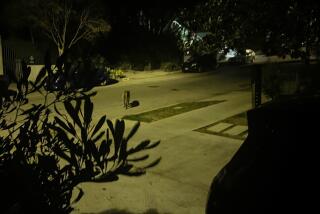Saber-Toothed Tiger Proves a Model Visitor at Mall
- Share via
Muscles flexed and fangs flashing, the tiger glided silently through throngs of startled visitors at the busy Beverly Center mall the other night. Until shopper Laura Morgan took aim and stopped it in its tracks.
“It’s a beautiful animal,” Morgan said, shooting a disdainful look at animal owner Corey McFarland. “But why did he have to be killed? He should never have been stuffed.”
McFarland grinned at the criticism--big game hunters laugh at danger, after all.
But McFarland is no hunter. And the mounted jungle cat that he was helping carry out of the Westside shopping center Tuesday was no animal. It was made of plastic and polyester, not teeth and fur.
The 29-year-old Carson resident built the unusual six-foot model of the extinct saber-toothed cat to prove that real-looking game trophies can be handcrafted instead of hunted down.
“It’s kind of a blow to taxidermists and to those who still blow away animals,” he said. “But humans are not the only life forms on this planet--I wouldn’t like it if bears or rabbits went around with guns and were mowing people down.”
The 120-pound replica is plenty realistic. In fact, scornful comments from shoppers at the Nature’s Own store where it was displayed for two weeks preceded the model’s departure Tuesday night.
“People thought it was real. A woman yesterday gave me a lecture about how killing and mounting animals is terrible,” said clerk Katherine Fleming. Store owner Jeffrey R. Marshall said the tiger model will be replaced with the genuine skull of a triceratops dinosaur that died a natural death.
McFarland, who works as an administrator for a container shipping company, said he spent a year and a half researching 40,000-year-old saber-toothed cats before settling on his animal’s look. Actual construction, using a precast skull, metal body framing, foam padding and stitched-together patches of synthetic fur, took about 3 1/2 months.
Part of the research, he said, involved hanging out at taxidermists’ shops where he watched experts mount deer heads. During those visits, McFarland pretended to be interested in acquiring stuffed animals of his own.
“I’d tell myself I could make a better nose, a better mouth. Finally I decided I could do a better animal than them,” he said.
He chose the saber-toothed cat as his test subject because he has been interested in prehistoric animals ever since his older brother gave him a set of toy dinosaurs 25 years ago.
McFarland’s model is slightly more muscular and colorful than cat statues on display at the La Brea Tar Pits. It has subtle spots and stripes because McFarland figures that the real-life cats needed camouflage in order to sneak up on prey.
Shelley Cox, laboratory supervisor at the Tar Pits’ Page Museum, said Wednesday that scientists’ view of the prehistoric creature is continually changing. Recently unearthed foot bones, for example, suggest that the saber-toothed cat’s claws were shaped differently than anyone thought.
McFarland said his hobby is evolving, too.
He has constructed another tiger in a leaping pose and is experimenting with an animated version. In the meantime, he is looking for a place to display his handiwork.
“My other saber-toothed tiger is in my mom’s living room in San Bernardino,” he said.
“She says she likes it, but she may be saying that because she’s my mom. It really doesn’t go with her furniture.”
More to Read
Sign up for Essential California
The most important California stories and recommendations in your inbox every morning.
You may occasionally receive promotional content from the Los Angeles Times.














